









Period Calculator
This calculator will help you to calculate the next Period cycle for a given set of input values with the steps shown.Related Calculators:BMI Calcualtor
Your Next 12 Period & Ovulation Cycles
Selected Year: 2025
| Expected Period Month | Expected Period Interval | Expected Ovulation Interval |
|---|

Neetesh Kumar | February 11, 2025
Share this Page on:
![]()
![]()
![]()
![]()
![]()
- 1. Introduction to the Period Calculator
- 2. What is the Formulae used?
- 3. How do I find the Period?
- 4. Why choose our Period Calculator?
- 5. A Video for explaining this concept
- 6. How to use this calculator?
- 7. Solved Examples on Period
- 8. Frequently Asked Questions (FAQs)
- 9. What are the real-life applications?
- 10. Conclusion
Keeping track of your menstrual cycle is essential for reproductive health, fertility tracking, and overall well-being. Whether you’re planning a pregnancy, avoiding surprises, or monitoring hormonal health, our Period Calculator helps you predict your next period with accuracy and ease.
This blog post will guide you through everything you need to know about menstrual cycle tracking, period calculations, and why our Period Calculator is the best tool for you.
1. Introduction to the Period Calculator
The Period Calculator is a simple tool that helps you predict your next period, ovulation days, and fertile window based on your past menstrual cycles.
- Predicts your next period based on cycle history
- Calculates your ovulation and fertile window
- Helps in tracking irregular cycles
- Useful for pregnancy planning and menstrual health tracking
This calculator is perfect for:
- Women tracking their menstrual cycle for personal health awareness
- Couples planning for pregnancy
- Individuals managing PCOS, endometriosis, or hormonal imbalances
- Athletes and professionals aligning their routines with their cycle
Using the Period Calculator ensures you are always prepared and in tune with your body’s natural cycle.
2. What is the Formulae used?
A typical menstrual cycle is counted from the first day of your period to the first day of the next period.
On average, a menstrual cycle lasts 28 days, but it can range from 21 to 35 days for most women.
The formula used in the Period Calculator is:
Where:
- Last Period Start Date = The first day of your most recent period
- Cycle Length = The average length of your cycle in days
To calculate ovulation, we use:
The fertile window (best time to conceive) is:
By entering your last period details and cycle length into the calculator, you get an instant estimate of your next period, ovulation day, and fertile window.
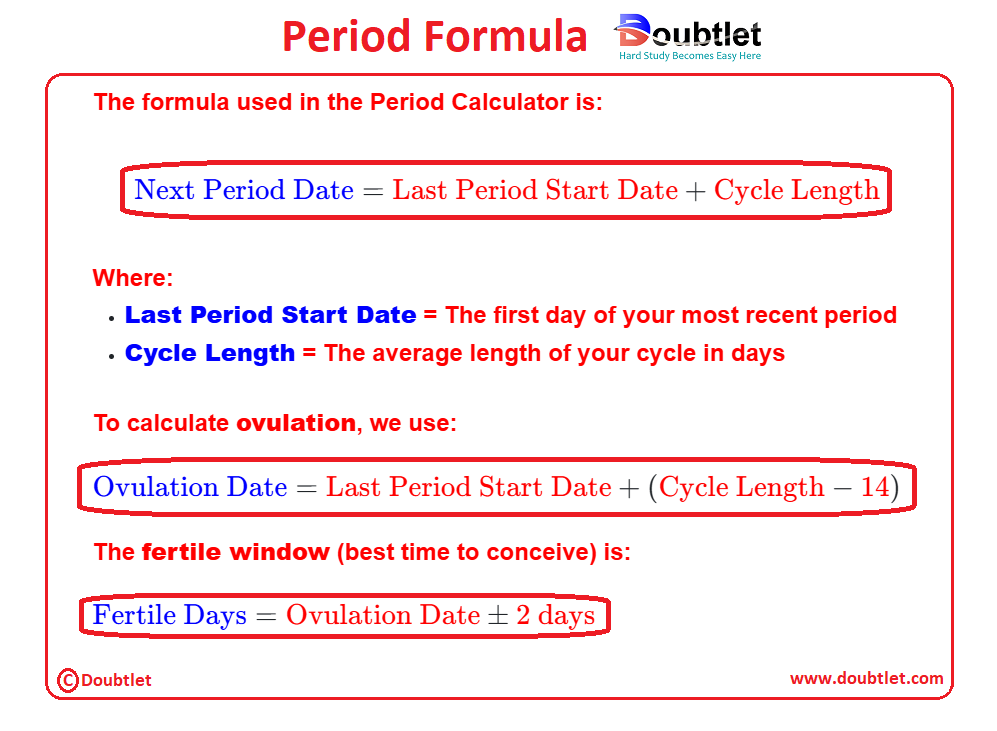
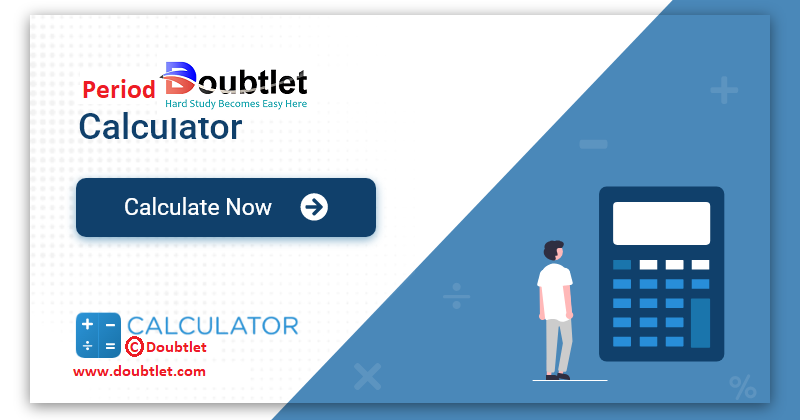
3. How do I find the Period?
Step 1: Know Your Cycle Length
- Track your period for 3-6 months to find your average cycle length.
- Most women have a cycle between 28-30 days, but it can be longer or shorter.
Step 2: Enter the First Day of Your Last Period
- This is the starting point for your menstrual cycle.
Step 3: Apply the Formula
Using the formulas above, the calculator predicts your next period date and ovulation period.
Step 4: View Your Results
- Next Period Date
- Ovulation Date
- Fertile Window (if tracking for pregnancy)
How to Precisely Calculate a Definite Menstrual Cycle and Menstrual Period?
Let us find out how to calculate your menstrual period. The menstrual cycle starts on the opening day of your period. The day one of this cycle is the day one of your menstrual period and so on. The bleeding is there for 3 to 5 days in a normal scenario and varies from one woman to the other.
Remember, the menstrual cycle commences from the day of your steady bleeding but not spotting. For example, you undergo spotting on April 3, however, the real bleeding initiated a day later. Subsequently, the first day of your menstrual cycle is April 4. Let us say you bleed for around 5 days, so, the time duration of your menstrual period is 5 days for the month of April.
Now, if your subsequent period is initiated on May 2, then your menstrual cycle length is the number of days from April 4 to May 1 (a day prior to your following period), which is 29 days. You should not count the initial day of your succeeding period, as that day will fall under the following menstrual cycle.
So, basically the menstrual period is the number of days you bleed frequently. And the menstrual cycle is the number of days from the primary day of the last period (LMP) to a day prior to the following period’s initiation. The average length or duration of the menstrual cycle is 28 days nevertheless it differs from women to women.
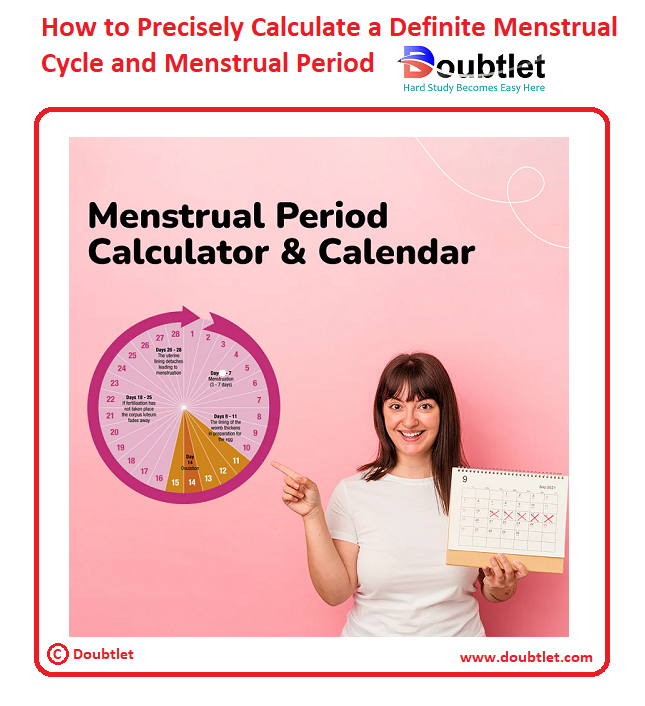
4. Why Choose Our Period Calculator?
Our calculator page provides a user-friendly interface that makes it accessible to both students and professionals. You can quickly input your square matrix and obtain the matrix of minors within a fraction of a second.
Our calculator saves you valuable time and effort. You no longer need to manually calculate each cofactor, making complex matrix operations more efficient.
Our calculator ensures accurate results by performing calculations based on established mathematical formulas and algorithms. It eliminates the possibility of human error associated with manual calculations.
Our calculator can handle all input values like integers, fractions, or any real number.
Alongside this calculator, our website offers additional calculators related to Pre-algebra, Algebra, Precalculus, Calculus, Coordinate geometry, Linear algebra, Chemistry, Physics, and various algebraic operations. These calculators can further enhance your understanding and proficiency.
5. A video based on how to Evaluate the Period.
6. How to use this calculator?
Using the Period Calculator is easy:
- Enter the first day of your last period
- Enter your average cycle length (e.g., 28, 30, or 35 days)
- Click Calculate – Instantly see:
- Your next period start date
- Your ovulation day
- Your fertile window
This tool ensures you never miss your period again!
7. Solved Examples on Period.
Example 1: Predicting Your Next Period
Last Period Start Date: April 1
Cycle Length: 30 days
Solutions:
Using the formula:
Your next period will start on May 1.
Example 2: Finding Your Ovulation Date
Last Period Start Date: April 1
Cycle Length: 28 days
Solutions:
You will ovulate on April 15.
Your fertile window (best time to conceive) is: April 13 - April 17.
8. Frequently Asked Questions (FAQs)
Q1. How accurate is the Period Calculator?
It is highly accurate for women with regular cycles. If your cycle is irregular, results may vary.
Q2. How do I track my menstrual cycle?
Keep a log of:
- Period start and end dates
- Cycle length
- Symptoms like cramps, bloating, and mood swings
Q3. What if I have irregular periods?
The calculator estimates based on your average cycle length. If your cycles are highly irregular, consult a doctor.
Q4. Can this calculator help with pregnancy planning?
Yes! It predicts ovulation and fertile days, making it a great tool for conception.
Q5. Can this calculator prevent pregnancy?
No. It estimates ovulation, but is not a substitute for contraception.
Q6. How long is a normal menstrual cycle?
A normal cycle is 21 to 35 days, with 28 days being the average.
Q7. Why does my period change dates?
Factors like stress, diet, exercise, or medical conditions can affect cycle length.
Q8. Can I use this calculator if I have PCOS?
Yes! But since PCOS causes irregular periods, it’s best to track multiple months for accuracy.
9. What Are the Real-Life Applications?
The Period Calculator is beneficial for:
- Personal Health Tracking: Understand cycle patterns and hormonal changes.
- Pregnancy Planning: Track ovulation and fertile windows.
- Education: Learn about reproductive health.
- Lifestyle Planning: Plan workouts, vacations, and events around your cycle.
Tracking your cycle can help detect irregularities early and improve reproductive health.
10. Conclusion
The Period Calculator is an essential tool for tracking your menstrual cycle, predicting ovulation, and planning fertility. Whether you’re tracking your health, trying to conceive, or avoiding surprises, this tool provides accurate and reliable predictions.
Stay informed and in control of your cycle. Try our Period Calculator today!
If you have any suggestions regarding the improvement of the content of this page, please write to me at My Official Email Address: doubt@doubtlet.com
Are you Stuck on homework, assignments, projects, quizzes, labs, midterms, or exams?
To get connected to our tutors in real time. Sign up and get registered with us.
Degree and Leading Coefficient Calculator
BMI Calculator
8th Pay Commission Salary Calculator
Age Calculator
Simple Interest Calculator
Compound Interest Calculator
Space Travel Cost Calculator
Weight on Mars Calculator
Comments(0)










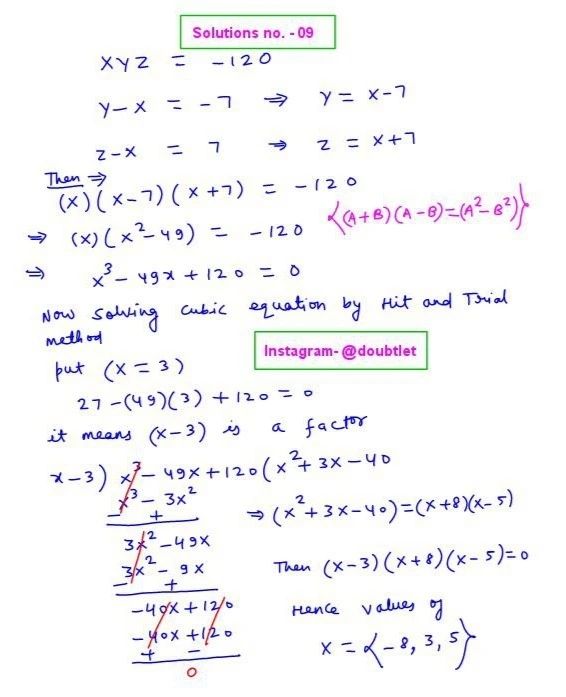
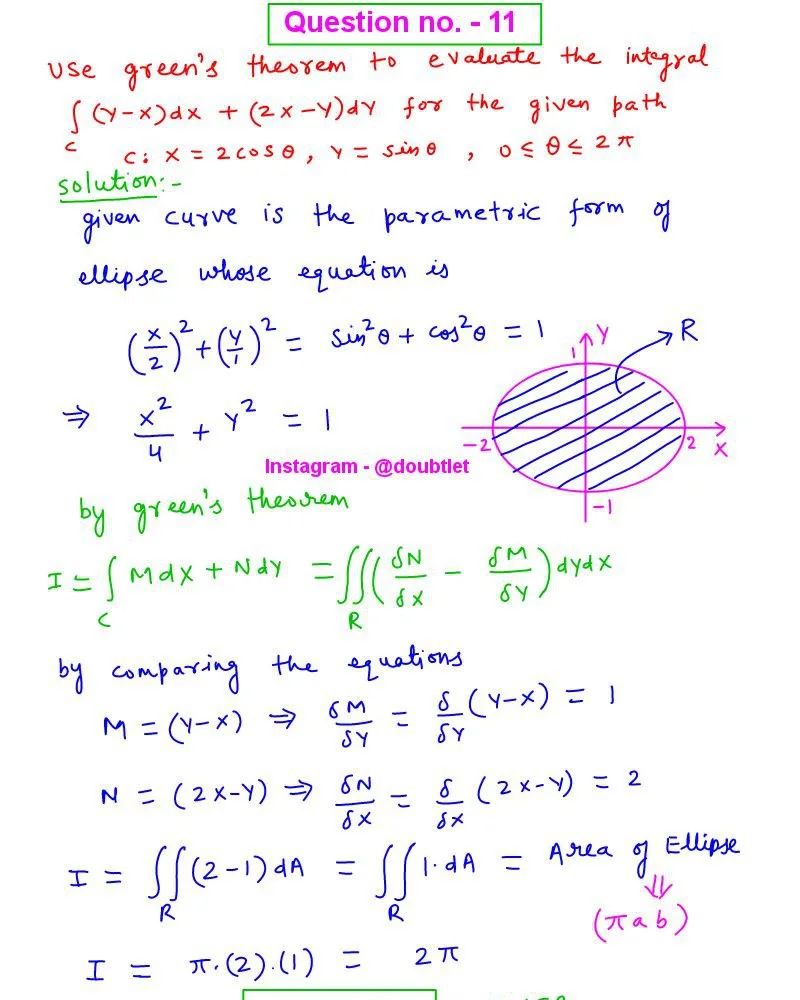

Leave a comment